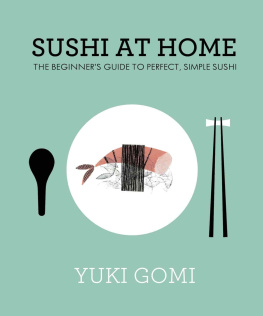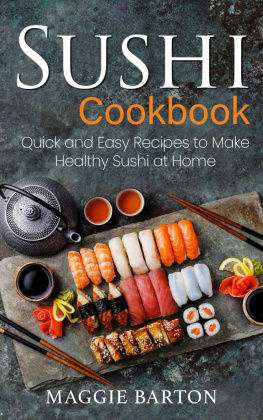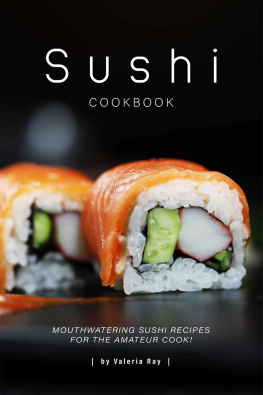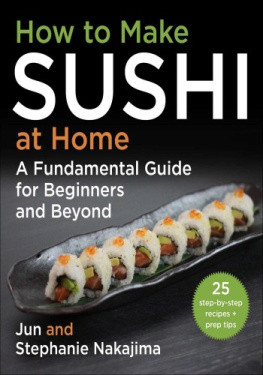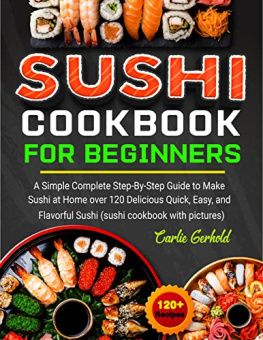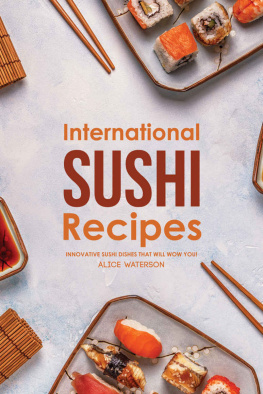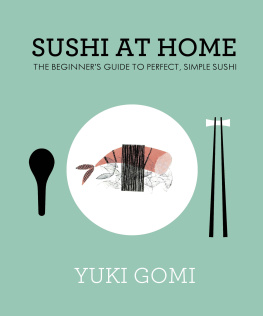Yuki Gomi - Sushi at Home
Here you can read online Yuki Gomi - Sushi at Home full text of the book (entire story) in english for free. Download pdf and epub, get meaning, cover and reviews about this ebook. year: 2013, publisher: Fig Tree, genre: Home and family. Description of the work, (preface) as well as reviews are available. Best literature library LitArk.com created for fans of good reading and offers a wide selection of genres:
Romance novel
Science fiction
Adventure
Detective
Science
History
Home and family
Prose
Art
Politics
Computer
Non-fiction
Religion
Business
Children
Humor
Choose a favorite category and find really read worthwhile books. Enjoy immersion in the world of imagination, feel the emotions of the characters or learn something new for yourself, make an fascinating discovery.
- Book:Sushi at Home
- Author:
- Publisher:Fig Tree
- Genre:
- Year:2013
- Rating:5 / 5
- Favourites:Add to favourites
- Your mark:
- 100
- 1
- 2
- 3
- 4
- 5
Sushi at Home: summary, description and annotation
We offer to read an annotation, description, summary or preface (depends on what the author of the book "Sushi at Home" wrote himself). If you haven't found the necessary information about the book — write in the comments, we will try to find it.
Sushi at Home — read online for free the complete book (whole text) full work
Below is the text of the book, divided by pages. System saving the place of the last page read, allows you to conveniently read the book "Sushi at Home" online for free, without having to search again every time where you left off. Put a bookmark, and you can go to the page where you finished reading at any time.
Font size:
Interval:
Bookmark:





Yuki Gomi is a Japanese chef who has taught thousands of people Japanese cooking and how to make their own sushi. After studying cordon bleu cookery in Chicago, she trained under Japanese master chefs, before moving to London and beginning to teach Japanese cooking classes. Sushi at Home is her first book.
www.yukiskitchen.com
To my students, future, past and present

Sushi in Japan
When I was a child and my mother would say that we were going to have sushi tonight, I would be filled with excitement. I was excited about the food, of course, but also about where and how we would be eating it would we be making it at home or going somewhere special? Sushi eaten at a restaurant and home-style sushi are quite different for Japanese people. Sushi is a unique food culture, a cuisine within a cuisine: anything from the blur of dishes as they pass in a kaiten (conveyor-belt) sushi restaurant; to super-fresh sliced nigiri, those beautiful slices of fish resting on a rice pillow, in a small restaurant next to Tsukiji fish market amongst the bustle of the market traders; to high-end Kyoto dining while watching geishas pass by; to the bento boxes you see hundreds of smartly dressed children taking to school every day.
My grandmother always took me to a fantastic traditional sushi restaurant. For me, the experience of eating sushi in this restaurant was completely different from cooking and eating it at home. When I walked in, I was greeted with different words from those used in other sorts of restaurants, and the quiet calm and the mesmerizing sight of the chefs flawless movements as he cut the fish made me feel immediately that I was somewhere special. It is this attention to detail, presentation, preparation and the enjoyment of the process that unites sushi in all its forms. When the Japanese salaryman rolls out his napkin, puts down his bento box and arranges his chopsticks to one side before beginning his lunch, it is the ceremony he has in mind, a chance to escape and enjoy something luxurious.
Japan has always had specialities sushi restaurants, tempura restaurants, eel restaurants, and so on. The people who work there spend years honing their skills. Itamae master sushi chefs and these are almost always men, rarely women begin by working at sushi restaurants as apprentices when they are teenagers. Training takes years: they start by washing the rice, and it can be four years before they progress to washing the fish, let alone cutting it. Although this may seem a strange and lengthy process, it demonstrates how much Japanese culture respects its food. Japanese people do not eat sushi every day, and it is often considered a meal for a special occasion. The array of Japanese restaurants serving ramen, katsu curry and yakitori in London alone is testament to the growing popularity and variety to be found within Japanese cooking.
Making Sushi at Home
I respect Japanese sushi culture, but as a woman from a younger generation who has studied in America and lived in the UK, I like to take a different approach: after all, with home cooking, you cant spend four years learning to wash rice. Thankfully, theres a difference between going out and respecting tradition, and making something lovely to eat at home.
With nigiri, you have to slice the fish very quickly, touching it only once in fact, my old mentor doesnt use his right hand at all to touch the fish and you would never make nigiri at home, because it wouldnt taste right. But you can make temari, which is very similar in style, easy to make, and looks stunning. If its nigiri you are looking for, then save your appetite for the many high-end restaurants and enjoy watching the beautiful work of a master sushi chef!
So the ingredients, the setting and the atmosphere may change, but the general approach in all cases is a real care for the foods preparation and the quality of ingredients. Sushi always feels like a treat, a fine-dining experience, but it can be prepared easily at home. Sushi is a cuisine in itself, defined in all its forms by the pride taken in making something really special and delicious. Whatever the setting, sushi is my favourite food and I always delight in teaching people how to make it.
Sushi is not something to be afraid of. You need to learn a few methods to prepare beautiful sushi at home, but dont worry this is not about spending ten years training in a Kyoto kitchen or using expensive equipment; in fact, Ill be showing you how to use a hairdryer to perfect your rice. And nowadays you can buy a huge range of Japanese products very easily, without breaking the bank.
The most important thing is keeping an open mind: whether you want to use caviar or cucumber, as long as you enjoy what you make, then that is fine. A simple pasta dish is truly great if you use fresh, good-quality pasta cooked properly; similarly, if you make good rice, then you can make wonderful sushi. Japanese food is very simple to make, it is one of the healthiest ways to eat and it can be easily incorporated into your daily life. Achieving the equivalent of al dente perfection can be a precise process, so follow the methods carefully and enjoy the challenge. Get the basics right, be discerning with your ingredients and experiment!
My Approach
Japanese food is so delicious that it is easy to forget that it is healthy too, and I love teaching people how to prepare it. My approach is based on three principles:
Chisan, chisho produce locally, eat locally
As far as possible use ingredients that can be bought easily and locally: ready-cooked crab, smoked salmon, mackerel, asparagus, cucumber, avocado, spinach and green beans, for example. Of course, we dont live in a bubble, and Japanese food would be impossible to create without some key ingredients from further afield. Luckily, sushi rice, nori, wasabi and other formerly hard-to-find products are all now widely available in supermarkets and online, which makes it much easier, but my sushi recipes are designed to be accessible and enjoyed by anyone keen to learn, in any location.
Nowadays you can eat everything, everywhere, at any time. However, I recommend trying to use the ingredients available to you, as inventiveness improves the experience. It was only when my family visited Tokyo that we would eat Edomae, or Tokyo-style sushi, for example. I love exploring different parts of England at the weekend and using Norfolk smoked fish or Cornish crab to create new recipe combinations, and I grow some of the more difficult-to-find ingredients, like the herb shiso, in my garden.
Otaku [be a] geek!
Talk to your grocer and your fishmonger. Care about the ingredients and the process. Be fussy about what you use in your dishes and where it comes from. There are no short cuts or tricks if you dont have good fresh fish or vegetables. When I first took my friends to Japan we caught the bus to Yamanashi, a journey of two hours or so. The whole way there, three elderly but very lively ladies were having a passionate chat. Keen to know the subject, my friend was surprised to discover that they had been talking about food in this case pickles for over two hours: the best way to pickle daikon, its health benefits, its taste, what time of year to do it, the beautiful colours you could achieve depending on which vinegars were used, and so on.
Font size:
Interval:
Bookmark:
Similar books «Sushi at Home»
Look at similar books to Sushi at Home. We have selected literature similar in name and meaning in the hope of providing readers with more options to find new, interesting, not yet read works.
Discussion, reviews of the book Sushi at Home and just readers' own opinions. Leave your comments, write what you think about the work, its meaning or the main characters. Specify what exactly you liked and what you didn't like, and why you think so.

